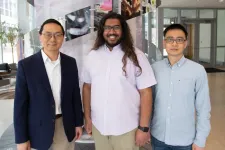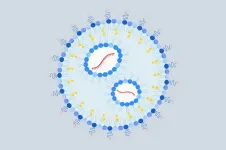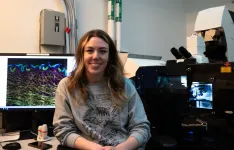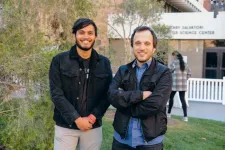(Press-News.org) Similar to how cells within human tissues communicate and function together as a whole, bacteria are also able to communicate with each other through chemical signals, a behavior known as quorum signaling (QS). These chemical signals spread through a biofilm that colonies of bacteria form after they reach a certain density, and are used to help the colonies scavenge food, as well as defend against threats, like antibiotics.
“QS helps them to build infrastructure around them, like a city,” described Dharmesh Parmar, a postdoctoral researcher in the lab of Jonathan Sweedler (CABBI/BSD/MMG), James R. Eiszner Family Endowed Chair in the department of chemistry. “Biofilms have channels, which allow passage of nutrients, and information in the form of chemical signals. They also allow crosstalk between colonies if there's a threat or the stress in the environment.”
Biofilm formation and the subsequent resistance to antibiotics can be especially dangerous for people with a weakened immunity or with diseases like cystic fibrosis (CF), which leads to a stagnant mucus surface inside the lungs that bacteria can more easily attach to. To better understand what surface factors influence or potentially inhibit biofilm formation in the presence of antibiotics, researchers from the Sweedler lab at the University of Illinois Urbana-Champaign, along with collaborators at the University of Notre Dame, measured rate of biofilm formation via QS in a bacteria commonly acquired in hospital infections, Pseudomonas aeruginosa.
P. aeruginosa forms biofilms rapidly on a variety of surfaces, which expedites when colonies start communicating using QS, and makes treatment with antibiotics difficult. Additionally, P. aeruginosa can vary in the thickness of the biofilm it produces. The “mucoid” strain produces a thicker biofilm than the non-mucoid strain, and is often linked to infections in patients with CF, a genetic condition which increases mucus viscosity and accumulation in the lungs.
In the study, both of these strains were grown on fabricated surfaces that varied in structure, with one being uniform or “unpatterned”, and the other being “patterned” with ridged blocks. Researchers then measured how quickly colonies were able to start communicating with QS while being grown either in the presence of antibiotics or not. QS was detected using mass spectrometry and Raman-imaging, which measured the presence of signaling molecules associated with the behavior. The first thing researchers noticed was that antibiotics slowed growth of a biofilm and production of QS molecules across both strains and structure types. Next, the researchers found that surface type had a large effect on the non-mucoid strain, in that the patterned structure was associated with longer latencies before expression of QS molecules were at their peak. This was not the case for the thicker mucoid strain.
“While the impact of the antibiotic slowing biofilm growth didn’t surprise us, the large and differential impact on surface structure was striking,” said Sweedler.
“In the non-mucoid strain, surface patterning had a huge impact on the QS signal properties,” Parmar added. “In the case of mucoid, the surface structure had very minimal impact on its metabolic signatures.”
The researchers also explored how the distribution of QS signaling molecules differed across different parts of the biofilm when grown on a flat surface and exposed to antibiotics. Samples were taken from the “static biofilm”, where the biofilm attaches to the surface, the “supernatant”, or liquid medium of the culture, and the “pellicle biofilm”, that forms on top of the liquid medium and interacts with the air.
Researchers found that the supernatant liquid and pellicle biofilms contained signaling molecules associated with a stress response, while the static biofilm did not contain these molecules. The researchers think this is because the liquid component of the biofilm is what allows bacteria to float along and start new colonies elsewhere, but in the process the bacteria are also exposed to threatening situations, such as presence of antibiotics.
By comparing QS behavior during biofilm growth across these different treatments, researchers can better understand how and what kind of molecules this species of bacteria use, and gain new insights on bacterial growth.
“P. aeruginosa biofilm is quite challenging to eradicate using currently available antibiotics, and so our goal with this study was to understand what are the factors that govern the growth and stability of these biofilms, and how bacteria escapes these biofilm structures to colonize new locations,” explained Parmar.
“The chemically information-rich approaches and analytical techniques we used allowed us to probe these complex molecular events related to biofilm formation across space and time.” Sweedler explained.
The team says the next step is to use these optimized analytical techniques to measure QS signals on lung slices from rats, instead of fabricated structures like those used in the current study. Because P. aeruginosa is often associated with infections in the lungs of CF patients, understanding how it forms biofilms in the lungs can help scientists engineer methods to slow or prevent bacteria growth in these patients. Parmar described one potential future application could be to engineer surfaces of medical devices to deter bacterial adhesion and biofilm formation. These findings could also be used to help prevent biofouling, which is when bacteria spoils or degrades biological products and surfaces.
The paper is published in ACS Infectious Diseases and can be found at https://doi.org/10.1021/acsinfecdis.2c00519
END
Bacterial signaling across biofilm affected by surface structure
2023-04-05
ELSE PRESS RELEASES FROM THIS DATE:
Researchers discover new class of ribosomal peptide with hemolytic activity
2023-04-05
Living organisms produce a myriad of natural products which can be used in modern medicine and therapeutics. Bacteria and other microbes have become the main source for natural products, including a growing family called ribosomally synthesized and post-translationally modified peptides, or RiPPs. The labs of Douglas Mitchell (MMG), John and Margaret Witt Professor of Chemistry, and Huimin Zhao (CABBI/BSD/GSE/MMG), Steven L. Miller Chair of Chemical and Biomolecular Engineering, at the University of Illinois Urbana-Champaign have been working in tandem to identify and analyze new RiPPs that could be good candidates ...
Nanoparticle with mRNA appears to prevent, treat peanut allergies in mice
2023-04-05
Peanut allergies affect 1 in 50 children, and the most severe cases lead to a potentially deadly immune reaction called anaphylactic shock.
Currently, there is only one approved treatment that reduces the severity of the allergic reaction, and it takes months to kick in. A group of UCLA immunologists is aiming to change that.
Taking inspiration from COVID-19 vaccines as well as their own research on the disease, they created a first-of-its-kind nanoparticle — so small it’s measured in billionths of a meter — that delivers mRNA to specific cells in the liver. Those cells, in turn, teach the body’s natural defenses to tolerate ...
5 Questions with CNSI’s Haley Marks
2023-04-05
Haley Marks is a project scientist for the Advanced Light Microscopy Lab (ALMS) at the CNSI at UCLA. She is a biomedical engineer with a specialty in nano-biosensor research, translational medicine, and optics education.
Since joining CNSI in 2022, Haley has served as a technical expert, providing advanced light microscopy training and services to ALMS users. Here she works on developing and optimizing ALMS’s existing super-resolution and high-speed optical methods, developing strategies and imaging tools for in vivo imaging, and optimizing and disseminating computational imaging techniques.
Haley has a passion for all things photonics, and enjoys 3D printing, materials ...
Young dog owners tend to cope well when their beloved pooch misbehaves, new study reveals
2023-04-05
A new study published in the CABI journal Human-Animal Interactions reveals that young dog owners tend to cope well when their beloved pooch misbehaves.
Past studies suggest that around 90% of dogs display undesired behaviours such as aggression and disobedience, but little is known about the impact of this on young people’s experiences and accompanying emotions.
A team of scientists interviewed young dog owners in Canada, aged 17 to 26 years, to try and determine their experiences with their pets and their coping strategies in response to bad behaviour.
This included barking occasional and persistent barking and, in extreme cases, being aggressive towards other dogs ...
Robots predict human intention for faster builds
2023-04-05
Humans have a way of understandings others’ goals, desires and beliefs, a crucial skill that allows us to anticipate people’s actions. Taking bread out of the toaster? You’ll need a plate. Sweeping up leaves? I’ll grab the green trash can.
This skill, often referred to as “theory of mind,” comes easily to us as humans, but is still challenging for robots. But, if robots are to become truly collaborative helpers in manufacturing and in everyday life, they need to learn the same abilities.
In ...
Hot probe tip contributes to making “transformer” semiconductor particles
2023-04-05
How can we make wearable devices like Spiderman’s suit that are thin and soft yet also feature various electrical and optical functionalities? The answer lies in producing novel materials that go far beyond the performance of existing materials and developing technology that enables the precise control of the physical properties of such materials.
Separating transition metal dichalcogenide (TMD) into a single layer just like graphene makes it transform into a thin, two-dimensional (2D) film material that exhibits the characteristics of highly performing semiconductors. By stacking two disparate ...
Series of new studies refute assumptions about link between power and concern about reputation
2023-04-05
Contrary to earlier research findings, people of power - think about politicians, celebrities or bullies in school - turn out to be no less concerned about their reputation, compared to those who have less influence and control within the society.
Previously, it has been assumed that since those who have the upper hand in the society - unlike the ‘powerless’ - are able to get away with commonly unacceptable behaviour (e.g. aggression and exploitation), would care less about any potential damages to their reputation.
However, a recent study by scientists at the University of Kent (United Kingdom) ...
Society matters LIVE: Lab made meat on the menu?
2023-04-04
• Research at Aston University focuses on both creating lab-based meat and its psychological acceptance
• Dr Eirini Theodosiou and Dr Jason Thomas will be speaking at April’s Society matters LIVE event
• Lab made meat on the menu? will take place at Cafe Artum in Hockley Social Club on Thursday 27 April.
Lab made meat will be the topic of the latest Society matters LIVE event from Aston University at Café Artum at Birmingham’s Hockley ...
Students use machine learning in lesson designed to reveal issues, promise of A.I.
2023-04-04
In a new study, North Carolina State University researchers had 28 high school students create their own machine-learning artificial intelligence (AI) models for analyzing data. The goals of the project were to help students explore the challenges, limitations and promise of AI, and to ensure a future workforce is prepared to make use of AI tools.
The study was conducted in conjunction with a high school journalism class in the Northeast. Since then, researchers have expanded the program to high school classrooms in multiple states, including North Carolina. ...
DZIF-project-derived start-up “EBViously“ announces first details of its EBV vaccine candidate
2023-04-04
EBViously, a spin-off from Helmholtz Munich (HMGU), is led by world-leading experts in Epstein-Barr virus biology, genetics, and immunity and was founded to develop a safe and highly effective preventive vaccine against a range of diseases caused by Epstein-Barr virus (EBV), including infectious mononucleosis, immune disorders, multiple sclerosis, and various cancers. The spin-off is based on a project of HMGU supported by the German Center for Infection Research (DZIF). The project leading to the spin-off was co-funded by the DZIF to enable GMP manufacturing ...






